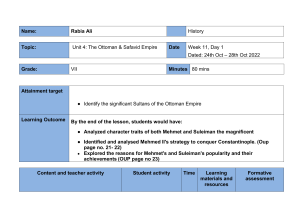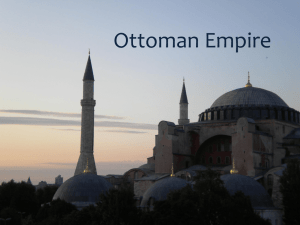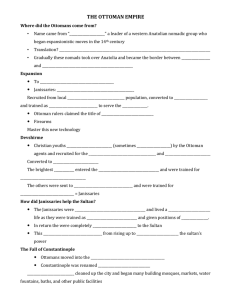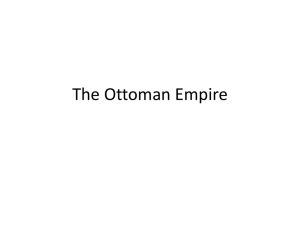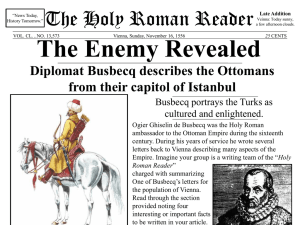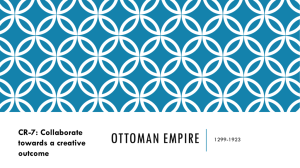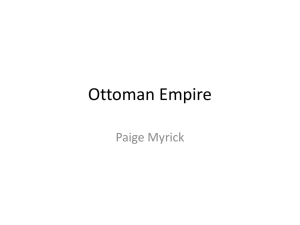Ottoman & Safavid Empires: 7th Grade History Lesson Plan
advertisement
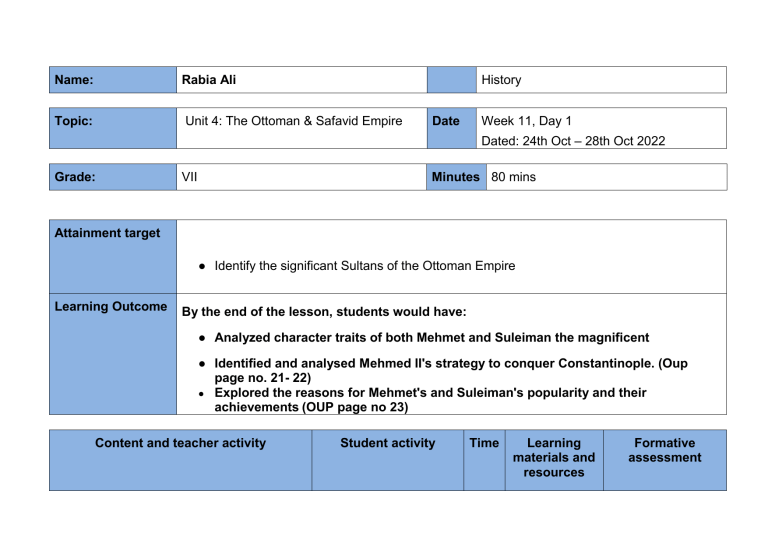
Name: Rabia Ali History Topic: Unit 4: The Ottoman & Safavid Empire Date Week 11, Day 1 Dated: 24th Oct – 28th Oct 2022 Grade: VII Minutes 80 mins Attainment target ● Identify the significant Sultans of the Ottoman Empire Learning Outcome By the end of the lesson, students would have: ● Analyzed character traits of both Mehmet and Suleiman the magnificent ● Identified and analysed Mehmed II's strategy to conquer Constantinople. (Oup page no. 21- 22) ● Explored the reasons for Mehmet's and Suleiman's popularity and their achievements (OUP page no 23) Content and teacher activity Student activity Time Learning materials and resources Formative assessment How are you explaining and demonstrating the topic? (The teaching strategies/ methodology selected) What are the students doing to understand the topic? HOOK: Students will be asked to read the following: “ No one shall disturb or give harm to these people and their churches! They shall live in peace in my state.These people who have become emigrants, shall have security and liberty. They may return to their monasteries which are located in the borders of my state.” Then they will be asked : 1. What is he trying to achieve through this firman? 2. Which personality traits as a leader are reflected in his words? Students will be thinking analytically and will be giving verbal responses. What resources will you use that will support the teaching and learning activities? 10 mi ns How do you plan to assess learning as it is happening? The students will be assessed on: Participation, engagement, verbal responses. 3. What would be the impact of his religious tolerance on the empire of this king? 4. Do you think Pakistan is also practising this kind of tolerance to the emigrants? Guess the country we are supporting in this regard. Responses will be taken from students and mind map will be made on the white board. Now teacher will ask students to read the given below poem written by Suleiman I, the sultan of sultans, and the strongest ruler, the loftiest king who defeats the kingdoms around the world, and the shadow of Allah in the Earth, am the son of Sultan Selim who is the son of Sultan Beyazid, Sultan Suleiman, Caesar of Rome, the sultan of Mediterranean Sea and Black Sea, and Thrace, and Anatolia, and Karaman and the City of Dulkadir and Diyarbakir and Kurdistan, and Iran and Damascus and Aleppo and Egypt and Mecca and Medinah and Jerusalem and the whole Arab land and Yemen and many more lands that our lofty ancestors conquered with their crushing powers and I conquered with my fire-scattering sword... - What character traits can you draw about him? On the otherside of the board teacher will jot their responses down. Later students will be told the name of the Sultan of Ottoman “ Mehmed II - the law giver”. After Hook ask students: What is the old name of Constantinople? The place was named after which King? Which kingdom was ruling Constantinople? PairWork: Students will be asked Study the map on page 20 and identify the important landmarks around istanbul(seas, jerusalem, italy and europe etc) 5m in Students will be shown a video about Mehmed II. Before playing the video students will be asked to focus on the strategies used by Mehmed II to conquer Constantinople. Methodology: Video Watch and feedback Video to be played twice. https://www.youtube.com/watch?v=V0do5E KoCjw Feedback will be taken from students by asking following questions: ● ● ● ● ● Who conquered Constantinople? What was Mehmed II's strategy to conquer Constantinople? What was the name of the canon he used during the war? Why did conquering Constantinople strengthen the Ottoman Empire? How did the Ottoman Empire gain control? Students will recognize the strategy used by Mehmed II to conquer Constantinople and students will be answering asked questions after discussing with each other. 10 mi ns Collaboration Visual representation Verbal responses ● ● ● What Hagia Sophia was before converted to a Mosque? Why was it converted into a mosque? What was the importance of Hagia Sophia for the Romans and Byzantine Empire? Verbal responses will be taken randomly. Jigsaw Reading + Written Task: Instructions: Students will be asked to explore both the rulers and what made them successful the significant expansions of land, religious tolerance and their achievements during the rule of Mehmed II and Suleiman respectively. Whole class will be divided into groups of 45 students each. - Half of the groups will be reading the topic “ Mehmed II” and the rest of the half groups will be reading the topic “ Suleiman the magnificent” .’ - Then they will be combined so that those reading mehmet will share their knowledge with the other group and vice versa 25 mi n Students will collaborate with each other and in groups they will read their allocated topics and will be sharing their learning with each other. Place Mat: - Two Placemat worksheets will be distributed in each group and they will be filling it after reading their topics. - One worksheet will be filled after reading their own topic 30 mi ns Achi evem ents Religio us Toleran ce Expansi ons of Lands - After that groups will be merged and in each group students who have read Mehmed II and Suleiman will sit together and share their learning with each other. - And another worksheet will be filled after learning from their peers. verbal Feedback of their learning will be taken randomly. Written Task: after reading their topics they will be filling their placemat worksheet Students will be asked to complete the following questions in their notebooks; 1. How did the Firman by Sultan Mehmet help the Ottoman Empire to survive for 600 years? 2. Explain why Sultan Suleiman was called “ the magnificent.” 3. Why was the conquest of Constantinople so important to the Ottoman? Wrap Up: Students’ responses will be read by the teacher and will be given feedback to them while checking their notebooks. students will be completing their written work in their notebooks. Students will show their written work to teacher and take feedback from them. 5 min s Discussion and Students’ Reflection engagement Name: Rabia Ali History Topic: Unit 4: The Ottomans and the Safavid Empires Date Grade: VII Minutes 40 mins Learning Outcomes By the end of the lesson students would have: Week 11, Day 3 Dated: 24th Oct – 28th Oct 2022 ● Identified how the Ottoman Empire achieved its glory through its distinctive features of governance and administration under the rule of competent Sultans. (Federal Book page no 56-58) Content and teacher activity How are you explaining and demonstrating the topic? (The teaching strategies/ methodology selected) Student activity What are the students doing to understand the topic? Time Learning materials and resources Formative assessment What resources will you use that will support the teaching and How do you plan to assess learning as it is happening? learning activities? Recall: Students will be asked following Learners will be giving answers questions to test their learning of verbally. previous lesson: 1. What was the Ottomans policy towards christians? 2. What regions did Mehmet expand into? and what areas did suleiman further expanded into? 3. Why was Suleiman Sharia’s law code important to the Ottomans? Feedback will be taken randomly and assessed informally on their learning. Elicitation: - What type of assemblies do we have in our parliament? 8 mins The students will be assessed on: Participation., verbal responses - What is the difference between provincial assembly and national assembly? - Why divide the parliament into two assemblies? Feedback will betaken randomly. Methodology: Read Out Loud Students will be told to open Federal textbook page no. 56 - 58 Randomly students will be chosen to read textbook page no. 56-58 and through teacher exposition, topics will be explained to students. -Central & Provincial Administration: will be explained through an organogram given on page. no 56. Pair work: Students will be taking notes during the lesson. 20 mins Notebooks, Pens Verbal and written responses, engagement Students will be given a copy of the image and in pairs they will be asked to understand what the pyramid is about. They will read the social structure and discuss it among themselves. Teacher will ask them to paste the picture in their copies and then take feedback. and social structure will be explained through teacher explanation. Students will be asked to make notes during the lesson. Feedback will be taken by asking them to complete few MCQs on worksheet and paste them in copies. 1. What was the name of the system that allowed non-Muslim Students will be giving written minorities within the Ottoman Empire to be governed by their own responses and will paste the worksheets in their notebooks. religious leaders? a. the conscessions b. the millet system c. the sharia law 5 mins 2. What were the Ottoman Empire’s elite slave infantrymen called? a. ghazis b. jannisaries c. samurais 3. In how many categories Ottoman social structure was divided ? a. 3 b. 4 c. 5 4. What was the name of the Ottoman levy that took adolescent Christian boys as slaves from the European provinces? a. devsirme b. divan c. kharaj 5. Which of the following territories was never conquered by the Ottomans? a. Algeria b. Balgaria c. Iran Feedback will be taken from students to gauge their learning. AFL: Pair Work Students will be reading text and devising questions and will Students will be asked to devise three analytical questions from both exchange their work with each topics in 5 mins and then they will other to learn from each other. be instructed to exchange their notebooks with each other to broaden their horizons. 7 mins on their written expression and engagement.

